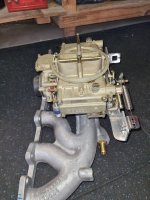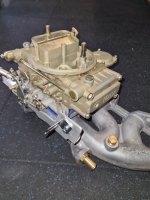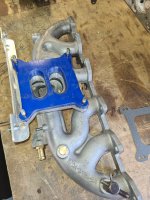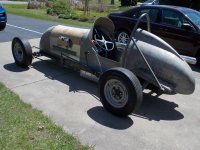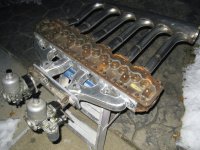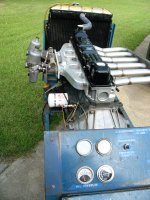cr_bobcat":9n8x6rcw said:
....
so consider ability to eek out power the top characteristic,
followed by ease of tuneability,
then finally cost.
Anything carburated goes!
Consider how different areas of the log run rich vs lean. We're looking for all out-performance, not necessarily a matched set!
I still think the NASCAR style RP2CPV, or some halfway house between that an POPIR, withh the right cam is the only way to go.
Think the least cfm at 1.5"Hg for the most performance as a measure of efficency.
Faron made 220 hp with just 446 cfm on a 250.
In Australia, one 650 cfm 4-bbl double pumper can make a 350 to 425 hp x-flow 250 engine
Holden made 230 hp with the 58 DCOE's and 1.85" venturis, so that's like 938 cfm at least a t 1.5"Hg, and on a 202.
Holman Moody, according to
Six Gun or FrenchTown Flyer, might have been trying to do the same thing...
http://fordsix.com/forum/search.php?aut ... 1&sr=posts
http://fordsix.com/forum/viewtopic.php? ... 56#p535256

The one above had a halfway house 4-bbl In line six intake that was supposed to be a transitional intake, using elements of 180 degree intake, with a degree of port on port inertial ramming.
Somewhere, the tri power three 1-bbl downdraft optimization or a 4-bbl on an I6 , can yield pay-dirt.
As I've said, Point is, There is nothing in between a pure IR system with 1452 cfm or more, and the 255-446 cfm 1-bbl per 2 cylinder item
In Australia, the 350 to 425 hp 250 X-flows are using 650 4-bbl double pumpers. What does a log I6 guy to get 650 cfm? Three 350 cfm Holleys is 742 cfm, and three DGAS38's is 679 cfm.
Its time to try an intermediate step, a semi Port on Port Independent runner set up.
And spend time creating the right cam to make it behave like its got 1500 cfm.
Fuel containment. A 3-bbl In line six, with a Restrictor plate cam.
The specific hp per rpm can go up.
I've heard so much from GT40 racers who found they lost rpm when the carb venturis were dropped below the idealized Weber Port on Port size verses cubic centimeter engine capacity, but none of them ever changed the cam to suit a smaller venturi size. IR systems need the idealized venturi size to work, but NASCAR and Historical C racing has been stuck with non IR systems, and developed cam strategies to make up for the loss of peak rpm.
What I am saying is don't go IR, go back a step, and copy NASCAR's 3'c's, the ability to Cheat on Carburation, Compression and Cam timing.
If IR sizes are taken to there expected requirements, then you'll end up with a Mini Prostock triple 650 cfm Z28 302 Cross Ram carbs and 12 throats like the three 4-bbl 250 in line Six Chevies with a 700 tho lift roller cam like used to rule the drag strips in the late 70's ,
CNC-Dude pit crewed with people like that.
The best Ford dual quads weren't strictly Independent Runner, they were a blend.
I'd start with downgrading a Double Pumper 4-bbl 650/351 combo into a 3 bbl 250, and work the a$$ out of the cam and legs to the pais of cylinders, making an HS Mikuni Flatside style system. Like the 1973 Circuit racing 202 xu1 Holdens ran.
So that's where it is for peak performance, not IR, because you can't package and feed it properly.
viewtopic.php?f=5&t=71515
This is where Holden was in 1973...Chrysler with there E49 was using independent Runner Aston Martin DB6 Vantage Weber DCOE45's with 40 chokes to get 295 HP net (306 HP Gross rated), while Holden was able to use Mini A series style Weber Splits, 3 56 DCO carbs with each second barrel deactivated to copy the triple CDS175 intake 190 hp gross rated engine into 230 hp net.
viewtopic.php?f=1&t=72684&p=559201#p559201
xctasy":9n8x6rcw said:
The topic is side mounting a plenumb., and log kit modifications or changes that allow this to take place. If you are using draft carbing, here is how it can work.
To show you what possible without even a turbocharger, but just a great cam and a nine port head nigh on over40 years ago.
The 202 cubic inch L6 Holden XU1 GTR 3300's in 1972 made 216 hp flywheel hp is race trim with this Three side draft Stromberg Zenith CDS175 carb set up. It was good enough to win a 6 hour, 500 mile road race in Bathurst Australia

from
http://www.partscloner.com.au/homephotoone.jpg
The next year, the 1973 Bathurst Torana XU1 GTR 3300 used triple 2-bbl 58 DCO carbs with half the barrels inactivated for about 230 HP flywheel net hp.
(Note, the description is wrong, its certainly a triple 58DCO set up from memory)

The 14 hp boost came solely from the use of those huge 1.85" 47 mm chokes in the 2-1/4" throttle carbs, and reliability from special Cologne Capri V6 style solid skirt cast pistons.







